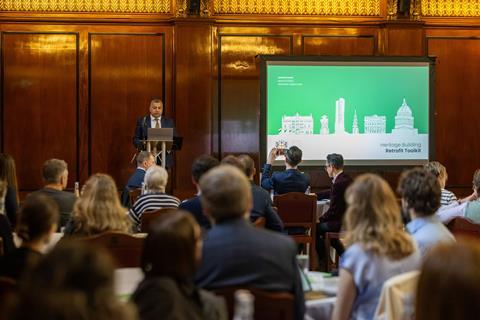Heritage practice Purcell worked on toolkit explaining how heritage assets can be retrofitted responsibly
The City of London has launched an initiative explaining how heritage buildings can be adapted to reduce their carbon emissions.
The Heritage Buildings Retrofit Toolkit was unveiled at the Merchant Taylors’ Hall on Threadneedle Street at an event which included speakers from Historic England and the Museum of London.

Created with the support of heritage practice Purcell, it consists of a nine-step methodology seeking to enable building owners to start the “responsible retrofit” of their assets, including building a business case.
There are more than 600 listed buildings in the Square Mile, 28 conservation areas, 48 scheduled monuments and four historic parks and gardens.
The Corporation, which has committed to making the City net zero by 2040, said its heritage structures pose a “significant” challenge given the diverse range of buildings and their specific planning and conservation considerations.
> Also read: City formally approves plan to build 1.2 million sq m of office space by 2040
Shravan Joshi, chairman of the City of London Corporation’s planning and transportation committee, said it was vital to secure a sustainable future for the City’s historic environment.
“Our ability to adapt our heritage buildings depends on developing a common understanding and promoting good practice of what can be achieved,” he said. “This toolkit provides a structured approach to such collaboration.”
The council’s climate action policy lead Alderman Alison Gowman added: “At the City Corporation we recognise that an important part of conserving our heritage buildings is ensuring they are fit for the future.
“This means making them as energy efficient as possible, reducing their carbon emissions and adapting them to changes to the climate.
“This toolkit provides a structured process for pursuing these actions, drawing on latest guidance and good practice.”
The launch of the toolkit comes two weeks after the council formally approved its plan to build 1.2 million sq m of office space over the next 16 years under its City Plan 2040.
The document sets out how the district will become a seven-day-a-week cultural and leisure destination while keeping on track with its carbon reduction targets.
















No comments yet